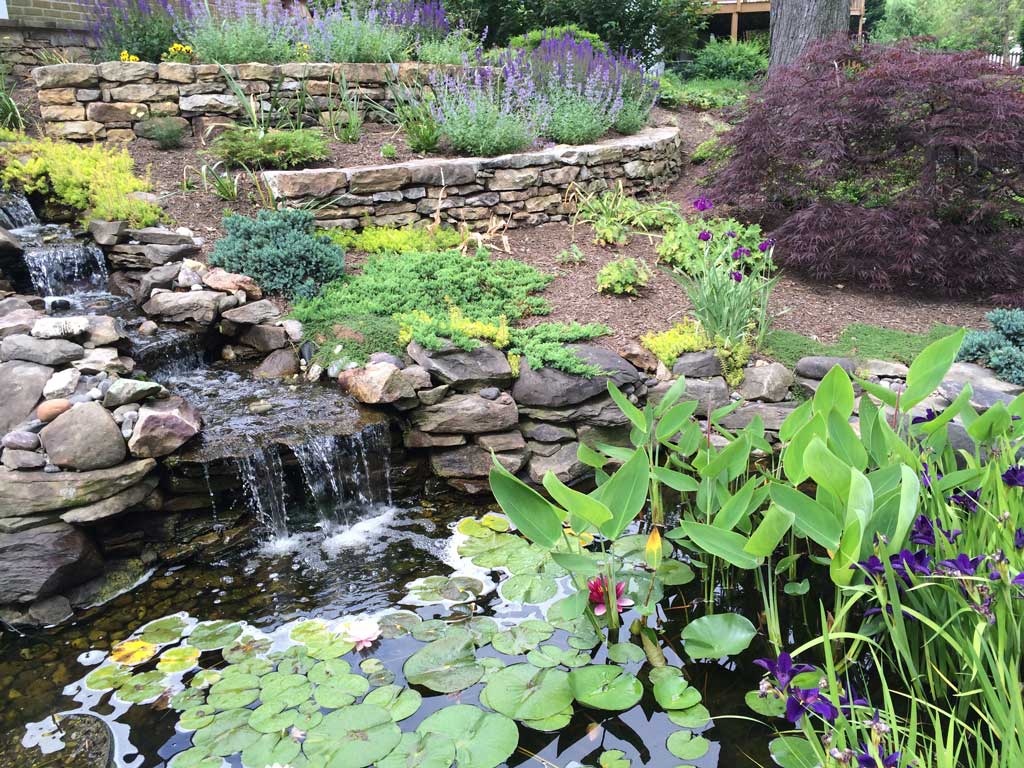Attain a Beautiful Outdoor Sanctuary With Thoughtful Steep Hillside Landscaping Solutions
Transforming a high hill into a captivating exterior sanctuary presents unique obstacles that require innovative landscape design options. By resolving problems such as erosion control and access, one can produce a harmonious mix of charm and functionality. Methods such as terracing, the installment of maintaining walls, and the option of native plants play crucial duties in this process. In addition, integrating water features can additionally enhance the landscape's attraction. Nevertheless, comprehending the intricacies of these components is important for attaining a really natural and inviting setting. What methods will best suit your hill's details characteristics?
Recognizing Steep Hillside Obstacles
Landscaping on steep hills presents unique obstacles that call for mindful factor to consider and calculated planning. The inclination of the surface can bring about concerns such as soil erosion, water drainage, and minimal availability, all of which should be addressed to develop a useful and visually pleasing outdoor space.
Among the main interest in high hillside landscaping is disintegration, which can arise from heavy rains or incorrect drain. This not only influences plant health and wellness but can additionally threaten the security of the slope. Implementing reliable disintegration control steps, such as growing deep-rooted vegetation or making use of mulch, is important in maintaining the stability of the landscape.

Creating With Terracing Methods
To alleviate the obstacles postured by high hillsides, including terracing strategies can be a reliable remedy. This layout strategy changes a sloped landscape right into a collection of level, level locations, developing an aesthetically striking and useful exterior room. Terracing not just assists to avoid soil erosion but also facilitates far better water drain, which is essential in maintaining the health of plants and the security of the hill.
When creating terraces, careful consideration of the incline's angle and the dirt type is important. Each balcony needs to be purposefully put to maximize sunshine direct exposure while reducing the risk of drainage. Using native plants on each degree can improve biodiversity, promote sustainability, and reduce upkeep requirements. Additionally, including paths in between terraces can boost availability and encourage expedition of the landscape.
Terraced gardens can serve multiple functions, including veggie production, ornamental displays, or outside seating locations. By utilizing materials that mix harmoniously with the surrounding setting, the terracing can enhance the total aesthetic charm of the residential property. Ultimately, thoughtful terracing changes high hills into practical, gorgeous rooms that invite interaction and satisfaction.
Executing Maintaining Walls
When faced with the obstacles of steep terrain, carrying out maintaining walls can supply both architectural support and aesthetic enhancement to a landscape. These wall surfaces offer to avoid dirt disintegration, maintain inclines, and develop level areas for gardening or recreational usage. Steep hill landscaping. By properly managing water overflow and minimizing dirt activity, retaining walls secure your landscape financial investment while boosting safety

Professional installment is important to ensure the long life and effectiveness of preserving walls. Correct drainage systems must be included to alleviate hydrostatic pressure, protecting against structural failing. Consulting with landscape experts will certainly ensure that the style aligns with your general vision while sticking to local guidelines.
Choosing Native Plants
Choosing indigenous plants for your landscape design uses numerous environmental and visual benefits. Steep hill landscaping. Native plants are adjusted to the neighborhood climate and soil problems, calling for less water and maintenance contrasted to non-native varieties. This flexibility not only saves sources yet also promotes a much healthier ecological community, as native plants support regional wild animals, consisting of pollinators such as and butterflies
Integrating indigenous vegetation into your high hillside landscape design can enhance soil stability, Clicking Here minimizing disintegration and site advertising a well balanced ecological community. Deep-rooted native plants help anchor the soil, making them optimal for sloped locations. In addition, these plants often show vivid shades and varied appearances, developing an aesthetically appealing landscape that harmonizes with the surrounding environment.
When picking native plants, consider their growth behaviors, seasonal passion, and compatibility with other varieties. Organizing plants with comparable water and sunlight demands can result in a more natural layout, while likewise simplifying maintenance. By choosing indigenous plants, you not just cultivate a sustainable exterior sanctuary however likewise contribute favorably to the neighborhood biodiversity, making sure that your landscape prospers for many years to come.
Incorporating Water Attributes
Including water functions into your high hillside landscaping can significantly boost both the visual appeal and ecological capability of the area. The sound of moving water produces a serene ambience, while visually, it can work as a centerpiece that draws the eye and includes depth to the landscape.
When selecting water features, take into consideration choices that complement the all-natural contours of your hillside. Waterfalls, as an example, can cascade the slope, developing visual interest and advertising healthy water drainage. Fish ponds can also be incorporated into the style, encouraging neighborhood wildlife and supplying habitats for different species.
Additionally, the placement of plants around these functions is crucial. Indigenous water plants not just enhance the elegance of the water feature however also add to its eco-friendly balance by filtering system toxins and offering food for neighborhood fauna.
Maintenance is an additional key aspect; ensure that your water function is internet made for simple maintenance. An appropriately created feature will call for minimal intervention, permitting you to enjoy the charm and harmony it supplies without excessive labor. Eventually, attentively bundled water features can change your high hillside landscape right into a captivating outdoor oasis.
Final Thought
In conclusion, transforming a high hill into a stunning outside oasis necessitates thoughtful landscaping approaches that deal with erosion control and ease of access. The integration of terracing strategies, the application of keeping walls, and the option of indigenous plants are vital components of reliable layout.
Comments on “Best erosion control methods for Steep hill landscaping success.”